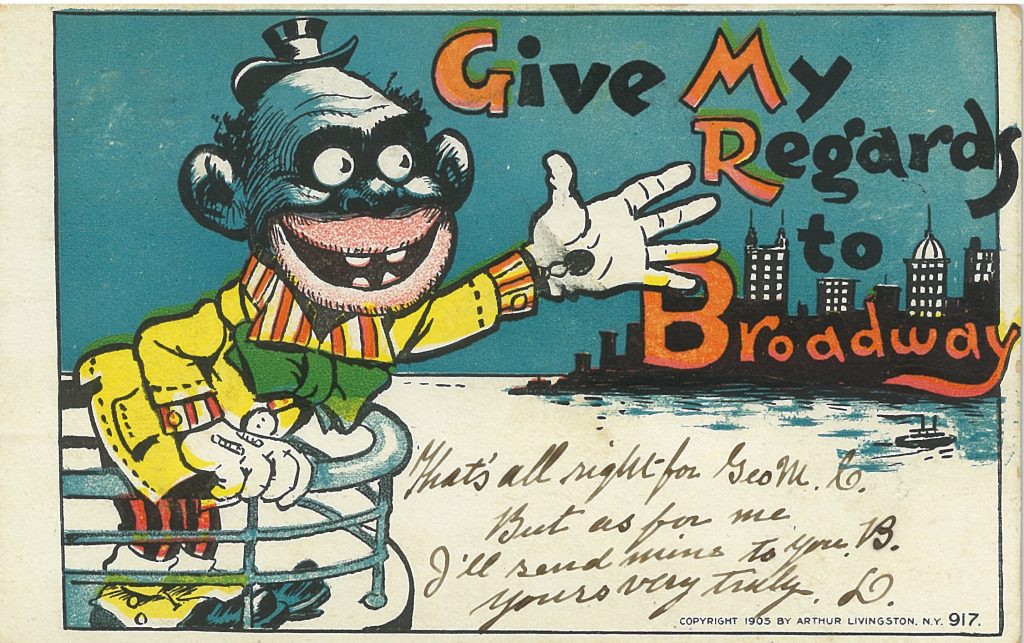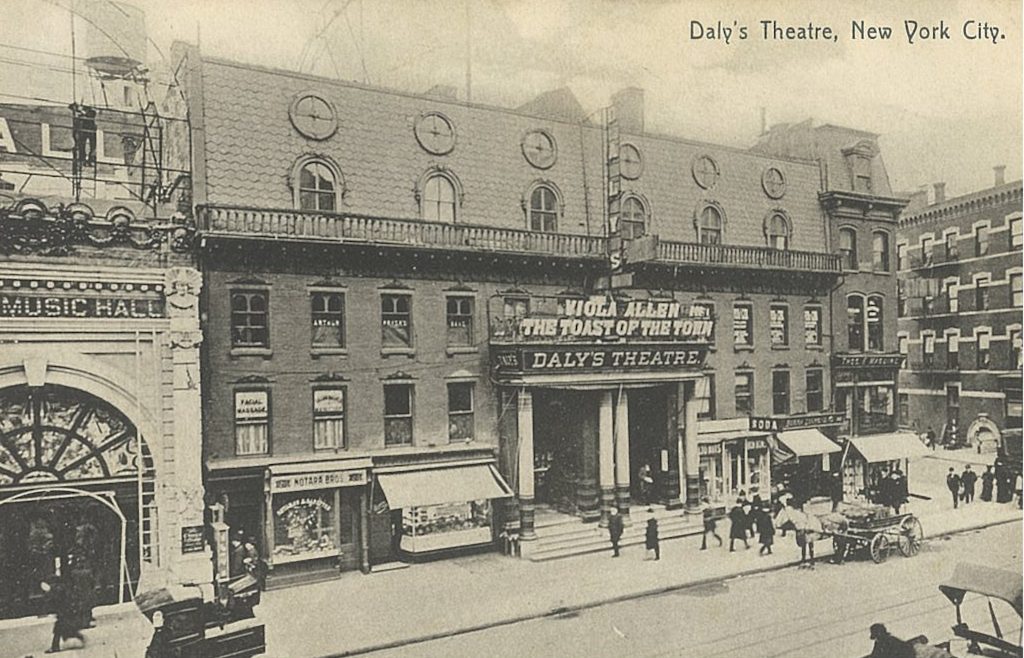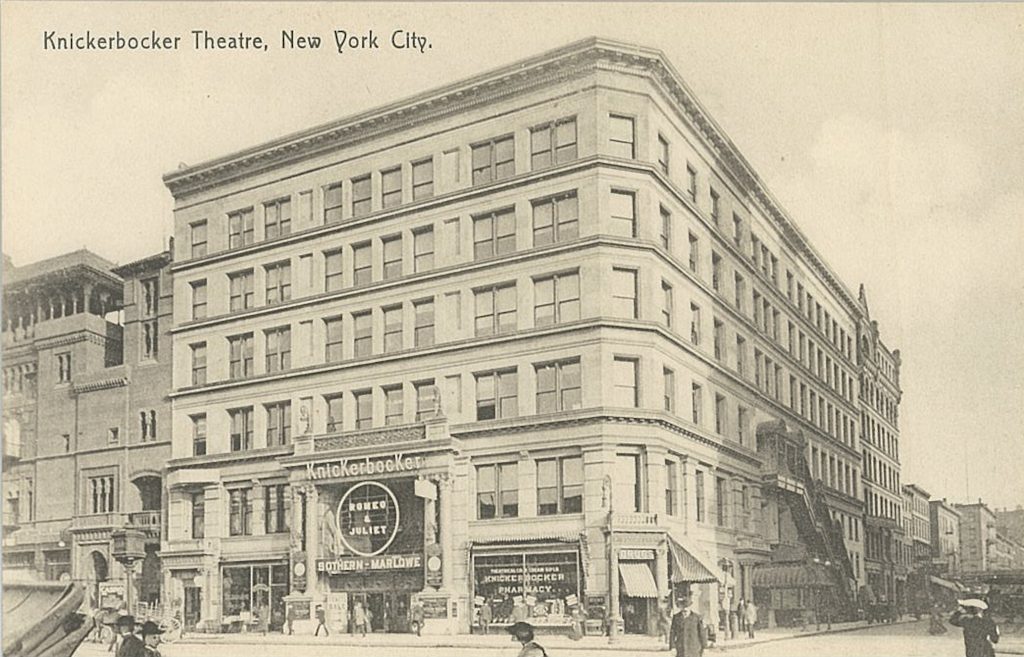Hy Mariampolski
Give My Regards to Broadway
Act 1 – New York’s Legitimate Theaters

To understand the growth and development of theater in New York it is helpful to follow how theatrical institutions – theaters, theater districts, and acting companies – meandered through the city over the course of the mid-19th to mid-20th centuries. In this five-part series, we’ll review the history of the city’s so-called “legitimate” theaters, that is, those devoted to performances of opera, drama, and musicals. This designation distinguishes this category from other types of theaters devoted to vaudeville, burlesque, and filmed entertainment that were also constructed in theater-crazed New York.
New York’s Academy of Music located in the Union Square neighborhood at 14th Street and Irving Place is a good place to begin this exploration. This 4,000-seat auditorium with outstanding acoustics was designed by Alexander Saeltzer – also the architect for the Lenox Library and Anshe Chesed Synagogue. Opened in 1854, it served as New York’s principal opera venue until overtaken by the Metropolitan Opera, which opened at Broadway and 39th Street in 1883.
The Academy of Music was not New York’s first opera house. That honor goes to the Italian Opera House built on Lower Broadway in 1833 by Lorenzo da Ponte, Jewish-born Italian librettist and collaborator of Mozart who immigrated to New York following failures to get established in Venice, Vienna, and London. The opera venture was not successful though da Ponte later gained local recognition as Columbia University’s first professor of Italian.
The Astor Opera House was built in 1847 after the demise of da Ponte’s venture and served for a while as the launching point for several Verdi operas, including the American premiere of Nabucco. Unfortunately, the theater’s flagrant elitism and elevation of English Shakespeareans led to the notorious Astor Place Riots in 1849 in which working class rioters were shot by police authorities resulting in well over 100 casualties. The theater never recovered from the riots and closed in 1853 just in time to be replaced by the Academy of Music.
The edifice may have changed but the elitism persisted at the Academy which sold shares and precious box seats to wealthy, old-money patrons. Opera season openings became the highlights of New York’s social scene until the Academy of Music abandoned opera in 1886 unable to withstand competition from the Met. Afterwards, the venue became known for vaudeville, labor rallies, trade shows and the extraordinarily licentious “French Balls.”
The building was torn down in 1926 along with its next-door neighbor Tammany Hall, which contained the historic vaudeville venue Tony Pastor’s, and replaced by the Consolidated Edison Building. A new 3,000-seat Academy of Music, a movie palace designed by Thomas Lamb was built across 14th Street by William Fox in 1927. That theater remained devoted to films through the 1960s and was then converted to a concert hall and later during the 1980s into a dance club called the “Palladium.” Purchased and demolished by New York University, the location today is occupied by their Palladium Residence Hall.
Located just a block away at 15th Street and Irving Place in the Union Square neighborhood the Irving Place Theatre started out as the venue for sophisticated German theater, including the first German translations of George Bernard Shaw, but after 1910 became an important Yiddish Theater. In 1918, Maurice Schwartz took over this establishment renaming it the Yiddish Art Theater and presented a more sophisticated and intellectual product than the sentimental and proletarian fare being offered by competitors along Second Avenue. Schwartz’s brand of theater could not make it on its own, so before closing in 1950, several other forms of entertainment were tried here, including burlesque, Italian and Soviet propaganda films, to supplement the Yiddish shows.

New York’s theater district was inexorably leaving Union Square and marching up Broadway to the Herald Square area. At that time, this zone constituted the northern reaches of the “Ladies Mile” shopping district, boasting many fine new hotels and eateries as well as the new Pennsylvania Station which opened in 1910.
Daly’s Theatre was located on the southwest corner of Broadway and W. 30th Street. Known for a while as the Broadway Theatre, it was built in 1867 as a museum/theatre by John Banvard. Renamed for its later owner, the theater was operated by Augustine Daly from 1879 until his death in 1899. Seating 1,170, the venue was known primarily for Edwardian musical comedies, such as The Geisha and San Toy, and the work of, for example, Arthur Sullivan, Sidney Jones, and Lionel Monckton. After Daly the theater was operated by a succession of managers, including the Shubert Brothers, and later went over to burlesque. The house turned to movies from 1916 to 1920, when it was demolished.

The distinctive 1882 Moorish Revival design of the Casino Theatre by architects Francis Hatch Kimball and Thomas Wisedell made it a landmark at Broadway and West 39th Street. It was unique on the inside as well as the outside being the first theater to be entirely illuminated by electricity thereby reducing the threat of conflagrations which had destroyed numerous houses that previously had been lit and warmed by gaslight and candles. The theater which seated 1300 after an expansion, was known for staging long-running operas, operettas, and musical comedies. It hosted the American premiere of the Verismo operatic masterpiece Cavalleria Rusticana (Rustic Chivalry) by the Italian composer Pietro Mascagni. The theater was also known for the Floradora series and The Vagabond King. The Floradora girls, Broadway’s first chorus line, became notorious when the husband of one of its former stars Evelyn Nesbit murdered the noted architect Stanford White for having had an illicit affair with the dancer when she was younger.
The Casino Theatre and its next-door neighbor the Knickerbocker Theatre were torn down in 1930 to make way for expansion of the Garment Center as the heart of the Theater District was moving north of 42nd Street. The 1,500-seat Knickerbocker Theatre, at the corner of Broadway and West 38th St., earlier known as Abbey’s Theatre lasted from 1893 to 1930 and was known for Edwardian musical comedy, Shakespeare and the classics, and the operettas of Victor Herbert. In a harbinger of what was to come in Times Square, the Knickerbocker introduced the first moving electrical sign on Broadway.

Another area always associated with musical creativity in New York was Tin Pan Alley. Located on 28th Street roughly between 5th and 6th Avenues, which Broadway runs through, it was the traditional location of music publishing businesses. “Tin Pan” was a slang description of a clanking piano. After the 1950s when the Theater District definitively moved north of 42nd Street, many management companies and publishing businesses moved to the Brill Building at 1619 Broadway and 49th Street. This later location acquired much of the same cachet that had attached to Tin Pan Alley, especially as a significant share of the music business transitioned from Broadway musicals to Rock ‘n’ Roll.
The Broadway Theatre near 41st Street stayed in operation from 1888 to 1929. It was located at 1445 Broadway just south of what would become Times Square. It was notable for a succession of popular English musicals and comic operas and operettas like the Prince of Pilsen, Veronique and The Vanderbilt Cup, all of which were promoted by attractive postcards. John Philip Sousa’s most enduring operetta El Capitan opened here in 1896. After about 1903, this theater increasingly drew back from musicals and switched over to Vaudeville and filmed entertainment. The theater was torn down in 1929 and replaced by the 33-story Bricken-Textile Building.

The Broadway Theatre
Maxine Elliott was an outstanding Broadway talent as an actress but also had an entrepreneurial streak that impelled her to build Maxine Elliott’s Theatre at 109 West 39th Street, jointly with the Shubert Brothers, in 1908. It was the last theater built below 42nd Street when the Theater District moved north of that dividing line. Designed by architect Benjamin Marshall of the Chicago based firm Marshall and Fox, the building was modeled after the neoclassical Petit Trianon at Versailles. After failing as a legitimate theater, the structure became a landmark for radio and television production. In later years, it was known as WOR Mutual Radio Theatre (1941–1944), CBS Radio Playhouse No. 5 (1944–1948), and CBS Television Studio No. 44 or Studio 51 (1948–1956). The theater was demolished in 1960 to make way for the Springs Mills Building.

The Maxine Elliot’s Theatre
When this “Give My Regards to Broadway” series continues, we will take a closer look at the Classics and the Operetta Era as the heart of the Broadway theater district moved North of 42nd Street after the turn of the 20th Century. One big change was that suddenly the name of Longacre Square was changed to Times Square.
Also important was the increasing concern with developing a distinctive American style of theatrical music. The military marches of John Philip Sousa were taking this part of the way. Then, George M. Cohan put a special twist into the mix with his popular song, “Give My Regards to Broadway.” As the Great War was capturing the attention of audiences everywhere, Cohan and another young upstart New Yorker, Irving Berlin, created the anthems that defined the wartime experience. Cohan assured Europe that the Yanks were coming “Over There” to redeem Europe and Berlin’s songs like “Oh, How I Hate to Get Up in the Morning,” let everyone know that it was not going to be easy.









Fascinating NYC history. Great Cards! Thanks Hy.
The fact that Longacre Square changed its name to Times Square sounds like the basis of a “Final Jeopardy!” clue.
Fascinating article. Looking forward to the other parts to learn about this history. I am collecting New York City theatre postcards and you have given me a way to organize them.
As usual Hy, a fascinating bit of history.
Fascinating to see how the different theatres were designed. Excellent article.
Did you have to use that offensive, stereotypic black face card with the title?
Thank you for your concern. The history of postcards indeed is littered with expressions and images that were intended to be demeaning and insulting not only to African Americans but also to Jews, Native-Americans, Asians, rural people and even to Scandinavians. As a historian, however, I believe that these seeming stereotypes need to be confronted and understood in their context. In this case, examining this 1905 postcard by Arthur Livingston (#917,) illustrating the title of that year’s #1 hit song, the iconography of minstrelsy was intended to express something altogether positive about the contributions of Blacks as musicians and comedians… Read more »